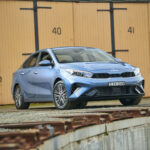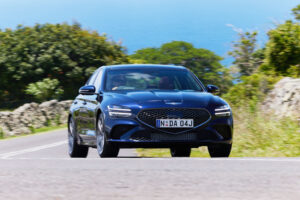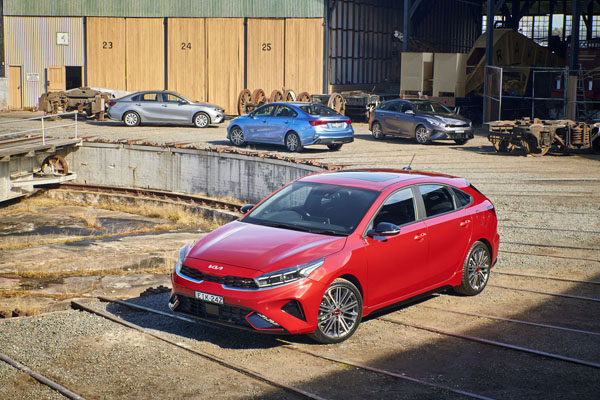
Kia Cerato has been around since 2003 and recently overtook Rio as the Korean company’s all-time biggest seller. More significantly, it is now snapping at the heels of Toyota Corolla and Hyundai i30 in the highly-competitive, albeit shrinking, small-medium car segment.
This success is likely to receive a further boost with the release of a mid-life upgrade that includes the recently-unveiled new Kia badge and branding, some styling tweaks and extra equipment.
As before there are four variants: S, Sport, Sport + and GT, each available in either sedan or hatchback bodies.
The overall shape of Cerato is almost coupe-like with its long bonnet linking into a roofline that slopes gradually to a short rear deck.
Styling changes at the front include revised version of the Kia ‘tiger nose’ grille as well as a new bumper, headlights and fog lights. At the rear the sedan gets new tail lights and changed to the boot and bumper lines.
Cerato S now gets LED upgrades to its daytime running lights, positioning lights and rear stop light.
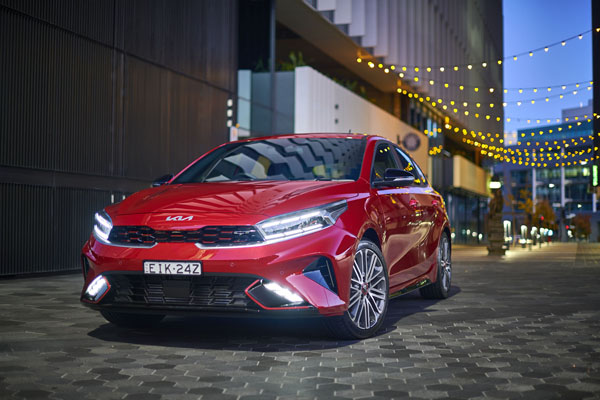
Cerato GT comes with red highlights on the grille, wheels and seat trim. A tilt and slide sunroof is standard.
Wheel sizes step up from 16-inch steel in the S to 17-inch alloy in the Sport and Sport + with the GT getting 18-inch alloys.
Kia’s new logo is on the bonnet, boot lid and steering wheel. We were a bit hesitant when we first saw the design but now that we’ve seen it in-situ we love it. It’s a sign of the new confidence from Kia that the name no longer needs to be spelt out.
Kia Cerato has a well-designed and practical interior with everything in the right place. There’s reasonable rear legroom although the sunroof in the GT does limit head space. Rear seat occupants also get a fold down armrest with cup holders, USB socket and air vents.
Rear storage is an impressive 402 litres in the hatch and 502 litres in the sedan.
Engine options remain as before with S, Sport and Sport+ powered by a 2.0-litre naturally-aspirated petrol generating 112 kW and 192 Nm at 4000 rpm, and the GT getting a 1.6-litre turbo-petrol with outputs of 150 kW and 265 Nm from 1500 revs.
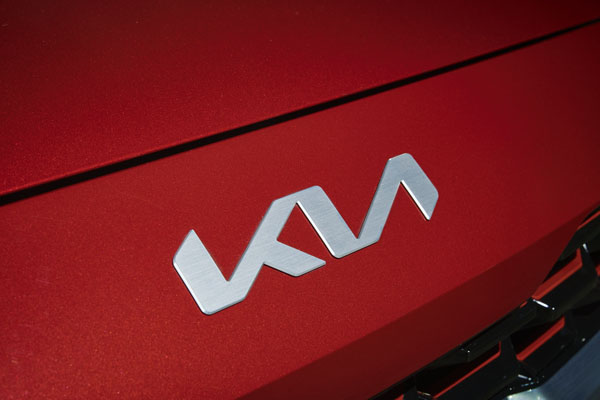
The 2.0-litre engine is paired to a six-speed automatic while the GT’s turbo engine gets a double-clutch (DCT) seven-speed. Minimal sales have led to the demise of the previous six-speed manual gearbox.
SAFETY
Standard safety features across the Cerato range include six airbags; enhanced ABS brakes; stability control; Autonomous Emergency Braking; Lane Keep Assist; Lane Follow Assist; Lane Departure Warning; Driver Attention Alert; front and rear parking sensors; High Beam Assist; reversing camera; and two IsoFix child seat anchor points.
The Sport + and GT also get Blind Spot Recognition; Blind Spot Collision Avoidance Assist; Rear Cross Traffic Alert; Safe Exit Warning; and enhanced AEB to include pedestrian and cyclist recognition.
An optional $1000 Safety Pack is available for the S and Sports models that adds Cyclist AEB; Electronic Parking Brake; Blind Spot Detection; and Rear Cross Traffic Alert.
INFOTAINMENT
Infotainment display on all variants is through LCD touchscreens, 8.0-inch in the Cerato S and 10.25-inch in the three higher-specced models. Android Auto and Apple CarPlay is available, plug-in or wireless depending on the variant.
The 4.2-inch TFT LCD driver’s instrument cluster is the same across the range. It’s simple, uncluttered and easy to read.
Satellite Navigation with SUNA traffic information, DAB digital radio, multi-connection Bluetooth and voice activation are all standard in Sport, Sport + and GT.
Cerato GT also gets a wireless smartphone charger and a JBL eight-speaker premium sound system. The other models get a six-speaker audio system.
DRIVING
We were able to drive both the entry-level Cerato S and the top-spec GT during Kia’s launch drive program down the south coast from Sydney and across to the Southern Highlands.
There’s good interior space with impressive shoulder, leg and head room although the GT’s sunroof did require us to drop the driver’s seat to its lowest setting.
Around town the S, with Kia’s 2.0 four-cylinder petrol engine, runs quietly at urban street speeds with the softer suspension and smoother ride.
The keen(ish) driver will be more likely to cough up the extra 11 grand for the better performance provided by the GT’s turbo-petrol engine, firmer suspension, increased body stiffness and better handling. We found ourselves using the paddle shifters to further enhance the drive experience.
Listed fuel consumption ranges between 6.8 and 7.4 litres per 100 kilometres on the combined cycle. We’ll compare that with real world figures when we do our extended test shortly.
SUMMING UP
The rise-and-rise of Kia in Australia continues apace to such an extent that it sat in third place behind Toyota and Mazda in the latest (May 2021) FCAI monthly sales numbers.
Cerato is easily the biggest single contributor and the latest upgrade adds to its appeal, especially so because the various improvements come with marginal price increases and Kia’s game-changing seven-year, unlimited distance warranty.
MODEL RANGE
S 2.0-litre petrol hatch & sedan: $25,990
Sport 2.0-litre petrol hatch & sedan: $27,990
Sport + 2.0-litre petrol hatch & sedan: $31,690
GT 1.6-litre turbo-petrol hatch & sedan: $36,990
Note: These are driveaway prices and include all government and dealer delivery charges.






